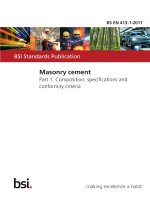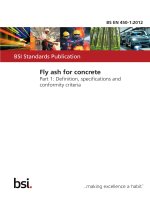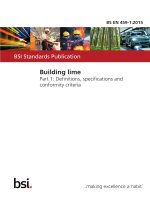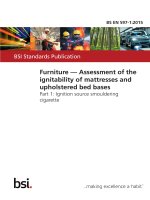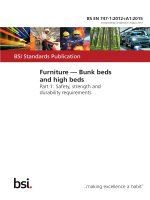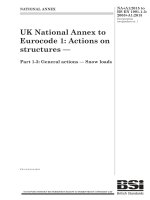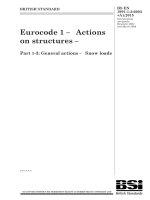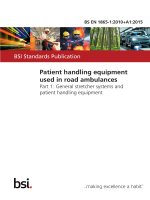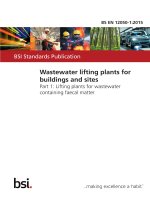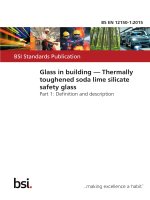Bsi bs en 01253 1 2015
Bạn đang xem bản rút gọn của tài liệu. Xem và tải ngay bản đầy đủ của tài liệu tại đây (1.25 MB, 36 trang )
BS EN 1253-1:2015
BSI Standards Publication
Gullies for buildings
Part 1: Trapped floor gullies with a depth
water seal of at least 50 mm
BS EN 1253-1:2015
BRITISH STANDARD
National foreword
This British Standard is the UK implementation of EN 1253-1:2015.
This document, together with BS EN 1253-2:2015, supersedes BS EN
1253-1:2003 and BS EN 1253-2:2003, which are withdrawn.
The UK participation in its preparation was entrusted to Technical
Committee B/505, Wastewater engineering.
A list of organizations represented on this committee can be
obtained on request to its secretary.
This publication does not purport to include all the necessary
provisions of a contract. Users are responsible for its correct
application.
© The British Standards Institution 2015. Published by BSI Standards
Limited 2015
ISBN 978 0 580 78397 5
ICS 91.140.80
Compliance with a British Standard cannot confer immunity from
legal obligations.
This British Standard was published under the authority of the
Standards Policy and Strategy Committee on 31 January 2015.
Amendments issued since publication
Date
Text affected
BS EN 1253-1:2015
EN 1253-1
EUROPEAN STANDARD
NORME EUROPÉENNE
EUROPÄISCHE NORM
January 2015
ICS 91.140.80
Supersedes EN 1253-1:2003, EN 1253-2:2003
English Version
Gullies for buildings - Part 1: Trapped floor gullies with a depth
water seal of at least 50 mm
Avaloirs et siphons pour bâtiments - Partie 1 : Siphons de
sol avec garde d'eau de 50 mm minimum
Abläufe für Gebäude - Teil 1: Bodenabläufe mit
Geruchverschluss mit einer Geruchverschlusshöhe von
mindestens 50 mm
This European Standard was approved by CEN on 22 November 2014.
CEN members are bound to comply with the CEN/CENELEC Internal Regulations which stipulate the conditions for giving this European
Standard the status of a national standard without any alteration. Up-to-date lists and bibliographical references concerning such national
standards may be obtained on application to the CEN-CENELEC Management Centre or to any CEN member.
This European Standard exists in three official versions (English, French, German). A version in any other language made by translation
under the responsibility of a CEN member into its own language and notified to the CEN-CENELEC Management Centre has the same
status as the official versions.
CEN members are the national standards bodies of Austria, Belgium, Bulgaria, Croatia, Cyprus, Czech Republic, Denmark, Estonia,
Finland, Former Yugoslav Republic of Macedonia, France, Germany, Greece, Hungary, Iceland, Ireland, Italy, Latvia, Lithuania,
Luxembourg, Malta, Netherlands, Norway, Poland, Portugal, Romania, Slovakia, Slovenia, Spain, Sweden, Switzerland, Turkey and United
Kingdom.
EUROPEAN COMMITTEE FOR STANDARDIZATION
COMITÉ EUROPÉEN DE NORMALISATION
EUROPÄISCHES KOMITEE FÜR NORMUNG
CEN-CENELEC Management Centre: Avenue Marnix 17, B-1000 Brussels
© 2015 CEN
All rights of exploitation in any form and by any means reserved
worldwide for CEN national Members.
Ref. No. EN 1253-1:2015 E
BS EN 1253-1:2015
EN 1253-1:2015 (E)
Contents
Page
Foreword ..............................................................................................................................................................3
1
Scope ......................................................................................................................................................4
2
Normative references ............................................................................................................................4
3
Terms and definitions ...........................................................................................................................4
4
4.1
4.2
4.3
4.4
4.5
4.6
4.7
4.8
Requirements .........................................................................................................................................8
Design and construction .......................................................................................................................8
Blockage prevention .............................................................................................................................9
Places of installation .......................................................................................................................... 10
Materials .............................................................................................................................................. 10
Thermal behaviour of floor gullies .................................................................................................... 11
Tightness ............................................................................................................................................. 11
Mechanical strength ........................................................................................................................... 11
Flow rates ............................................................................................................................................ 13
5
5.1
5.2
5.3
5.4
5.5
5.6
5.7
5.8
5.9
Test methods....................................................................................................................................... 14
Dimensions of apertures in gratings ................................................................................................ 14
Position of side inlets ......................................................................................................................... 14
Water seal ............................................................................................................................................ 15
Blockage prevention .......................................................................................................................... 16
Thermal behaviour .............................................................................................................................. 17
Loading test ......................................................................................................................................... 18
Mechanical strength ........................................................................................................................... 22
Tightness ............................................................................................................................................. 24
Flow rates ............................................................................................................................................ 26
6
Allocation and sequence of tests...................................................................................................... 27
7
Marking ................................................................................................................................................ 28
8
Evaluation of conformity .................................................................................................................... 28
Annex A (normative) Sequence of the tests .................................................................................................. 29
Annex B (informative) A-deviation.................................................................................................................. 30
Bibliography ..................................................................................................................................................... 31
2
BS EN 1253-1:2015
EN 1253-1:2015 (E)
Foreword
This document (EN 1253-1:2015) has been prepared by Technical Committee CEN/TC 165 “Waste water
engineering”, the secretariat of which is held by DIN.
This European Standard shall be given the status of a national standard, either by publication of an identical
text or by endorsement, at the latest by July 2015 and conflicting national standards shall be withdrawn at the
latest by July 2015.
Attention is drawn to the possibility that some of the elements of this document may be the subject of patent
rights. CEN [and/or CENELEC] shall not be held responsible for identifying any or all such patent rights.
This document, together with EN 1253-2:2015, supersedes EN 1253-1:2003 and EN 1253-2:2003.
This is the first part of EN 1253, a series of standards relating to floor gullies, roof drains and access covers
for drainage systems inside buildings. The EN 1253 series under the main title Gullies for buildings will
actually consist of the following parts:
—
Part 1: Trapped floor gullies with a depth water seal of at least 50 mm;
—
Part 2: Roof drains and floor gullies without trap;
—
Part 3: Evaluation of conformity;
—
Part 4: Access covers;
—
Part 5: Gullies with light liquids closure.
Since the latest versions of EN 1253-1 and EN 1253-2, the most significant technical changes are the
following:
a)
reduction of scope on trapped floor gullies with a depth of water seal of at least 50 mm for use in gravity
drainage systems;
b)
more definitive description of products;
c)
modification of terms and definitions;
d)
precision in definition of places of installation;
e)
consideration of liquid applied membranes as connecting components;
f)
precision of test conditions for flow rate testing;
g)
revision of loading test concerning test loads, loading speed as well as shape, size and point of impact of
test blocks in dependence on different configuration of gratings;
h)
revision of tightness tests for products for use with sheet floor coverings, membranes and liquid applied
membranes.
According to the CEN-CENELEC Internal Regulations, the national standards organizations of the following
countries are bound to implement this European Standard: Austria, Belgium, Bulgaria, Croatia, Cyprus, Czech
Republic, Denmark, Estonia, Finland, Former Yugoslav Republic of Macedonia, France, Germany, Greece,
Hungary, Iceland, Ireland, Italy, Latvia, Lithuania, Luxembourg, Malta, Netherlands, Norway, Poland, Portugal,
Romania, Slovakia, Slovenia, Spain, Sweden, Switzerland, Turkey and the United Kingdom.
3
BS EN 1253-1:2015
EN 1253-1:2015 (E)
1
Scope
This European Standard classifies floor gullies for use inside buildings, gives guidance for places of
installation and specifies requirements for the construction, design, performance and marking of factory made
gullies for buildings, irrespective of the material, for use in drainage systems requiring a trap with a depth of
water seal of at least 50 mm (further: floor gullies).
Although normally used to convey domestic wastewater, these floor gullies may convey other wastewater, e.g.
industrial wastewater, provided there is no risk of damage to components or of injury to health.
This European Standard does not apply to:
—
linear drainage channels as specified in EN 1433,
—
gully tops and manhole tops which are specified in EN 124,
—
roof drains and floor gullies without trap as specified in EN 1253-2.
2
Normative references
The following documents, in whole or in part, are normatively referenced in this document and are
indispensable for its application. For dated references, only the edition cited applies. For undated references,
the latest edition of the referenced document (including any amendments) applies.
EN 124, Gully tops and manhole tops for vehicular and pedestrian areas - Design requirements, type testing,
marking, quality control
EN 476, General requirements for components used in drains and sewers
EN 1253-3, Gullies for buildings - Part 3: Evaluation of conformity
3
Terms and definitions
For the purposes of this document, the following terms and definitions apply.
3.1
trapped floor gully
discharge fitting the top of which is a grating or cover capable of installation at ground or floor level, intended
to receive wastewater either through apertures in the grating and/or from side inlets and/or channels joined to
the body of the gully and to drain that wastewater through the outlet
Note 1 to entry:
See Figure 1.
Note 2 to entry:
drains.
In this European Standard, the term trapped “floor gully” includes linear products, such as channel
4
BS EN 1253-1:2015
EN 1253-1:2015 (E)
a)
Floor gully with side inlets and flange
for bonding membranes (example)
b)
c) Floor gully with side inlets and
flange for clamping flexible flooring
(e.g. PVC flooring) (example)
Floor gully with flange for clamping membranes
(fixed and loose flange) (example)
d)
Channel drain with flange for bonding
liquid applied membranes (example)
Key
1
finished floor
10
weep hole
2
grating/cover
11
flange for bonding membranes
3
extension
12
sediment bucket
4
trap
13
5
depth of water seal (H ≥ 50 mm)
6
outlet
7
body
14
flange for clamping flexible flooring with a clamping ring
8
side inlet
15
seal
9
access for cleaning
16
flange for bonding liquid applied membrane
connecting flange with counter flange
a
fixed flange
b
loose flange
Figure 1 — Types of floor gullies
3.2
grating
removable component with apertures which permits the discharge of water
3.3
frame
support for a grating or cover which is connected to a body either directly or by means of a membrane
clamping ring or an extension
5
BS EN 1253-1:2015
EN 1253-1:2015 (E)
3.4
cover
removable part of an access cover which covers the opening
3.5
body
part of a floor gully below or in the floor on which the grating/frame/extension is mounted, and to which the
pipework is connected
3.6
extension
component used to adjust the height of a grating or cover above a body
3.7
joint
connection between the adjacent ends of two components including the means of sealing
3.8
membrane clamping ring
component used to clamp a membrane or a sheet floor covering to a body or extension
3.9
connecting flange
separate or an integral part of a body or of an extension which receives a membrane or sheet floor covering
3.10
external diameter
OD
mean external diameter of the pipe barrel at any cross section
3.11
internal diameter
ID
mean internal diameter of the pipe barrel at any cross section
3.12
trap
removable or integral part of the body which prevents, by means of water seal, the passage of foul air from the
outlet to the inlet
3.13
depth of water seal
effective height of water in the trap (H) which prevents the passage of foul air
Note 1 to entry:
See Figure 1.
3.14
domestic wastewater
water polluted by the human life, including water discharged from kitchens, laundry rooms, lavatories,
bathrooms, toilets and similar facilities
[SOURCE: EN 16323:2014, 2.1.2.3]
3.15
industrial wastewater
wastewater discharge resulting from any industrial or commercial activity
[SOURCE: EN 16323:2014, 2.1.2.7]
6
BS EN 1253-1:2015
EN 1253-1:2015 (E)
3.16
sheet floor covering
flexible watertight finished layer for floors affixed to the flange by bonding, welding and/or by means of a
clamping ring
3.17
membrane
watertight and damp proof layer attached to the floor gully either in the floor or on the floor
3.18
head of water
depth h of a water line over the frame of the floor gully
Note 1 to entry:
See Figure 2.
Note 2 to entry:
For floor gullies without frame, the depth of water line is the lowest level over the finished floor.
Key
h
head of water
Figure 2 — Head of water for floor gullies
3.19
outlet
male or female connection to the discharge pipe
3.20
nominal size
DN
numerical indication of size which is a convenient integer approximately equal to the internal diameter (DN/ID)
or the external diameter (DN/OD) in millimetres
3.21
clear opening
CO
diameter of the largest circle that can be inscribed within the unsupported area of the grating
7
BS EN 1253-1:2015
EN 1253-1:2015 (E)
3.22
test load
specified load which a component is required to withstand
3.23
liquid applied waterproofing kit
particular combination of a defined set of components to be installed in liquid form for waterproofing by
application and/or incorporation and/or joining of the components in accordance with particular design
methods
Note 1 to entry:
The liquid applied watertight kit is usually a paste-like composite material or a combination of separate
materials that can be poured, spread or sprayed on the subsurface by brush, roller or similar suitable applicator.
4
Requirements
4.1
4.1.1
Design and construction
General
Floor gullies shall be capable of being connected to the pipework system covered by relevant European
Standards, and, when installed in accordance with the manufacturer's instructions, shall form an integral part
of the building. There shall be no movement possible between the body and the floor, which would impair the
functioning of the installed gully.
In areas where pressure testing of the pipe system is necessary floor gullies for use in the ground floor shall
enable such test to be performed.
The upper surfaces of frame and grating shall be flush. When in position, it shall not be possible for gratings
and covers to be dislodged from the frame, but they shall be easy to be released for e.g. maintenance and
cleaning.
Traps shall be prevented, by design features such as fixings or weights, from uncontrolled floating or
becoming displaced.
Floor gullies and their components shall be resistant to normal actions of mechanical and thermal character.
Floor gullies may be designed with or without side inlet.
Floor gullies shall be delivered with installation instructions.
All pipe joints to and from the floor gully shall be designed to be watertight in accordance with EN 476.
4.1.2
Appearance
Internal and external surfaces shall be free from sharp edges and imperfections which could impair functioning
of the floor gully or give risk of injury.
4.1.3
Apertures in gratings
Apertures can be holes or slots of any shape and may also be formed between grating and frame.
When measured in accordance with 5.1, the permissible aperture dimensions for gratings are given in
Table 1.
8
BS EN 1253-1:2015
EN 1253-1:2015 (E)
Table 1 — Apertures in gratings
Class
H
K
L
R
1,5
3
a
15
a
50
a
125
250
400
M
N
P
Dimensions of apertures in gratings
Minimum width
Maximum width
mm
mm
b
4
b
4
4
4
4
4
4
15 (max. 8 mm in barefoot areas)
10 (max. 8 mm in barefoot areas)
15 (max. 8 mm in barefoot areas)
25 (max. 8 mm in barefoot areas)
25
25
25
a
In commercially used premises, gratings may also be used with a maximum width of apertures up to 31 mm.
b
Apertures of less than 4 mm width are permitted and shall not form part of the hydraulic tests.
4.1.4
Side inlets
There are two types of floor gully with side inlets as follows:
1)
Type I: side inlets either partially or totally below the water level;
2)
Type II: side inlets completely above the water level.
The positioning of side inlets shall be checked in accordance with 5.2.
4.1.5
Depth of water seal
Floor gullies for wastewater shall provide a minimum depth of water seal H of 50 mm and be tested in
accordance with 5.3.1.
4.1.6
Resistance of water seal to pressure
When tested in accordance with 5.3.2, the applied pressure which just causes passage of air shall
be > 400 Pa.
Floor gullies with water seals of a depth (H) ≥ 60 mm are deemed to satisfy this requirement.
4.2
4.2.1
Blockage prevention
Access for cleaning
Floor gullies should have provision for mechanical cleaning of the outlet pipe systems leading to and from the
gully. When an opening with an airtight and watertight cover or plug is provided, the clear diameter of such
opening shall not be less than 32 mm in a floor gully having a nominal outlet size of DN 110 or below, and not
less than 50 mm in a gully of nominal outlet size DN 125 to DN 200.
Any opening provided for mechanical cleaning shall be tested in accordance with 5.4.1.
9
BS EN 1253-1:2015
EN 1253-1:2015 (E)
4.2.2
Self-cleansing capacity
The self-cleansing capacity of floor gullies which cannot be cleaned by removing the trap, or by an access for
cleaning in accordance with 4.2.1, shall be tested in accordance with 5.4.2.
When tested in accordance with 5.4.2, the expelled volume of glass beads for each of the flow rates in the
interval between 0,3 l/s and 0,6 l/s shall be greater than that indicated by the straight line between the two end
points 0 % at 0,3 l/s and 50 % at 0,6 l/s. Expulsion of glass beads shall commence at a flow rate less than
0,3 l/s, and at least 50 % of the glass beads shall have been expelled at a flow rate of 0,6 l/s.
4.2.3
Anti-blockage
Floor gullies and their components shall not be liable to clogging. Floor gullies with gratings or covers
removed shall be capable of accommodating the passage of a 8 mm diameter ball when tested in accordance
with 5.4.3.
4.3
Places of installation
4.3.1
General
A guide for selecting the class of a floor gully appropriate to the place of installation is given below. The
selection of the appropriate class is the responsibility of the specifier.
a)
Class H 1,5: Areas where no load is expected.
b)
Class K 3:
c)
Class L 15: Areas with light vehicular traffic, such as in commercially used premises and public areas.
d)
Class R 50: Areas with vehicular traffic, such as in commercially used premises and factories.
e)
Class M 125: Areas with vehicular traffic, such as car parks, factories and workshops.
f)
Class N 250: Heavy duty industrial areas subject to forklift traffic, such as food processing areas,
chemical or process plants.
g)
Class P 400: Extra-heavy duty applications including food processing areas, chemical or process plants,
where gullies are subjected to industrial forklift trucks and/or where heavy vehicles are manoeuvring.
Areas without vehicular traffic, such as dwellings, commercial and some public buildings.
Classes E 600 and F 900 gully tops conforming to EN 124 may be used for all areas subject to special
stresses such as exhibition halls, market halls, factory sheds and aircraft hangars.
4.3.2
Exceptions
Non-load bearing gratings for places of installation which are not accessible to vehicles and pedestrians
(protected by suitable masonry surroundings) and which are not covered by the places of installation listed
above nor by EN 124 shall at least conform to the test requirements given in 5.6 for class H 1,5.
4.4
Materials
Materials shall withstand a maximum intermittent wastewater temperature of 95 °C.
Materials shall withstand the stresses likely to occur during installation and operation.
10
BS EN 1253-1:2015
EN 1253-1:2015 (E)
Floor gullies made of materials which are not inherently corrosion-resistant shall be protected by corrosion
prevention treatment.
For industrial wastewater applications, the chemical compatibility and exposure to continuous elevated
temperatures of materials with the transported fluids should be determined separately between the specifier
and the manufacturer.
4.5
Thermal behaviour of floor gullies
Floor gullies shall be classified as follows:
—
Class A: Application in any place of installation;
—
Class B: Application restricted to bathrooms in private dwellings only for DN 32 to DN 75.
When tested in accordance with 5.5, floor gullies and their components shall show no deformation or change
in the components' surface structure which could affect their fitness for use.
4.6
Tightness
4.6.1
Odour-tightness
When tested in accordance with 5.8.1, the pressure shall not drop below 180 Pa over a period of 15 min.
4.6.2
Watertightness of bodies
No leaks shall occur when tested in accordance with 5.8.2.
4.6.3
Watertightness of extensions
Where the situation dictates tightness between extension and body, the joint between the extension and the
body shall be watertight when tested in accordance with 5.8.2.
4.7
Mechanical strength
4.7.1
Loading strength
Floor gullies and/or gratings are classified by loading strength, when tested in accordance with 5.6, into the
following classes: H 1,5, K 3, L 15, R 50, M 125, N 250, P 400.
Floor gullies not accessible to either vehicular or foot traffic are not classified.
4.7.2
Clamping ring
When tested in accordance with 5.7.2, the clamping ring shall not change its position and shall not show any
damage that impairs function after testing.
4.7.3
4.7.3.1
Additional requirements according to the installation
Extensions for gullies for use with sheet floor coverings
Floor gullies with extensions which are intended for non-imbedded use where deformations between floor
gully and extension may occur shall be tested in accordance with 5.7.1 and shall afterwards comply with the
requirement of 4.6.2.
11
BS EN 1253-1:2015
EN 1253-1:2015 (E)
4.7.3.2
Floor gullies for use with a membrane
Floor gullies for use with a membrane shall be fitted with a connecting flange in accordance with Table 2.
Table 2 — Connecting flanges
Minimum effective flange width
mm
Type of seal in flange area
Connecting flange with counterflange
Fixed
a
Loose
Flange for
bonding
Flange for
welding
Bitumen covering
—
bonded
—
—
100
—
—
clamped
70
60
—
—
Membranes manufactured
from plastics or elastomers
with or without wearing
surfaces
—
attached with adhesive
—
—
—
clamped
50
40
—
—
—
welded on membrane
—
—
—
50
Liquid applied membranes
with or without wearing
surface
—
—
30
—
a
30
—
This value is also applicable to gullies fitted with a skirt membrane at the manufacturer's works.
For floor gullies where a clamping ring without weepholes is used, the connection of a flange shall be tight
when tested in accordance with 5.8.3.
4.7.3.3
Floor gullies for use with a sheet floor covering
Floor gullies for use in floor constructions where the floor covering is a watertight synthetic material such as
PVC shall be fitted with a sealing flange in accordance with Table 2 and/or with a membrane clamping ring
and shall be watertight when tested in accordance with 5.8.3.
4.7.3.4
Floor gullies with factory fixed skirt membrane
When tested in accordance with 5.7.3, there shall be no peeling at ≤ 100 N.
4.7.3.5
Floor gullies for use with liquid applied membranes
Floor gullies for use with liquid applied membranes with or without wearing surface shall be fitted with a flange
for bonding in accordance with Table 2 and shall be watertight when tested in accordance with 5.8.3 after
thermal cycling test in accordance with 5.5.2 has been concluded.
12
BS EN 1253-1:2015
EN 1253-1:2015 (E)
4.8 Flow rates
4.8.1
Water through the grating
When tested in accordance with 5.9.1, floor gullies shall be capable of discharging at flow rates given in
Table 3.
In addition to the requirements in Table 3, the manufacturer shall supply the flow rate at a head of water of
10 mm in the technical document for each reference of product. Alternatively, a flow rate curve could be used.
Table 3 — Minimum flow rates for floor gullies
Nominal size of outlet
a
Floor gullies
(qgrate)
DN/OD
DN/ID
32
Head of water h
l/s
mm
0,4
30
40
0,4
0,6
40
50
0,6
0,8
50
0,8
63
0,8
75
0,8
70
0,8
75
0,8
90
0,8
100
1,4
100
20
1,4
110
1,4
125
2,8
160
a
Minimum flow rate
125
2,8
150
4,0
4,0
All dimensions not mentioned in this table shall be tested with the next higher dimension.
Where any floor gully without side inlets is used to receive the discharge from a single shower head, the
minimum flow rate shall be 0,4 l/s. Such products shall be marked specifically.
13
BS EN 1253-1:2015
EN 1253-1:2015 (E)
4.8.2
Water through the grating and side inlets
When tested in accordance with 5.9.2, floor gullies shall be capable of discharging at flow rates q given below.
a)
b)
5
5.1
Floor gullies up to DN 63 with one or more side inlets:
1)
qgrate see Table 3;
2)
qside ≥ 0,8 l/s;
3)
qside = 0,8 l/s and qgrate ≥ 0,3 l/s (h = 20 mm);
floor gullies equal to or greater than DN 70 with one or more side inlets:
1)
qgrate see Table 3;
2)
qside ≥ 0,8 l/s (each side);
3)
qside and qgrate = 0,8 l/s + 0,6 l/s (h = 20 mm);
4)
qside1 and qside2 = 0,8 l/s + 0,3 l/s.
Test methods
Dimensions of apertures in gratings
By means of suitable measuring instruments or balls of suitable sizes in accordance with Table 1, check that
the dimensions of the apertures comply with the minimum and maximum dimensions specified in 4.1.3.
5.2
Position of side inlets
Close the side inlet(s) and fill the trap with water. Check whether the lowest connecting point of side inlet(s) is
above the water level (see Figure 3).
14
BS EN 1253-1:2015
EN 1253-1:2015 (E)
a) Type I floor gully
b) Type II floor gully
Figure 3 — Testing the position of side inlets
5.3 Water seal
5.3.1
Depth of water seal
Measure the difference between the water level when the water seal is entirely full and the lowest point of
trap.
5.3.2
Resistance of water seal to pressure
Mount the floor gully in a test arrangement as illustrated in Figure 4, and fill the trap with water. Close the flap
and set a pressure of −400 Pa by means of the bypass valves. Open the flap and fill the trap with water.
Close the flap and slowly open after about 5 s. Repeat this procedure until the trap no longer loses water, but
no more than 5 times.
Remove 8 mm of water height; this corresponds to the reduction in the depth of water seal due to evaporation
over a period of disuse.
Subject the trap on the outlet side to a positive pressure such that flow of air just occurs. Record the pressure.
With the flap closed, set the desired negative pressure with the bypass valves, and read the manometer. The
sensors in the trap are connected to the recording device. When the flap is closed rapidly, the desired vacuum
pressure is established immediately.
15
BS EN 1253-1:2015
EN 1253-1:2015 (E)
By reversing the fan and securing the flap in the closed position, the arrangement can be used also for the
measurement of the resistance to positive pressure.
Key
1
fan
2
bypass valves
3
flap
4
water seal
4a
connection to pressure recorder
4b
connection to water level recorder
5
drain cock
6
pressure measuring device (manometer)
Figure 4 — Typical test arrangement for determining the resistance of water seals to pressure
5.4
5.4.1
Blockage prevention
Access for cleaning
Demount and remount those parts of the floor gully which are designed for cleaning access to the floor gully
itself and/or to the pipework to which it is connected. Measure and check for compliance with the requirements
of 4.2.1.
5.4.2
Self-cleansing capacity
Supply cold water at (15 ± 10) °C at a rate of 0,2 l/s, 0,3 l/s, 0,4 l/s and 0,6 l/s to the test box.
3
At each of the water flow rates, supply the floor gully, with grating/cover removed, with 200 cm of glass beads
3
3
of (5 ± 0,5) mm diameter and a density of 2,5 g/cm to 3,0 g/cm . Supply the beads at a steady and uniform
3
rate for 30 s. Continue the flow of water for a further 30 s. Measure, in cm , the volume of glass beads that
has passed through the floor gully. Conduct the test three times at each discharge rate. The average of the
three results shall be taken.
5.4.3
Anti-blockage
Pass a ball of
80−0 ,5 mm diameter through the floor gully, with the grating/cover removed, from the inlet to the
outlet merely by tilting the floor gully in the appropriate directions, no other force being applied to the ball.
16
BS EN 1253-1:2015
EN 1253-1:2015 (E)
5.5
Thermal behaviour
5.5.1
Temperature cycling
Mount the floor gully in accordance with Figure 5. Connect a suitable pipe to the outlet of the floor gully (the
outlet shall be open all the time). When different versions of the same components exist, the test shall be
done for the most unfavourable of their combinations.
Admit water through the grating or, if this is not possible, through the side inlet(s) as follows:
1)
(0,5 ± 0,05) l/s of hot water at (93 ± 2) °C for (60 ± 2) s;
2)
pause for (60 ± 2) s;
3)
(0,5 ± 0,05) l/s of cold water at (15 ± 10) °C for (60 ± 2) s;
4)
pause for (60 ± 2) s.
Repeat this cycle 1 500 times (100 h) for class A products and 360 times (24 h) for class B products.
Check to ensure that there is no deformation or change in surface texture of any component which would
impair the fitness for use.
This test does not apply to floor gullies made exclusively of metallic materials.
5.5.2 Additional test for floor gullies for use with sheet floor coverings and liquid applied
membranes
This additional test shall be applied to floor gullies intended for installation in floor constructions where the
floor covering is a watertight material. The floor covering may be connected to the floor gully by bonding,
bonding and a clamping ring combination, or by a clamping ring alone.
Mount the floor gully in the test box in accordance with the manufacturer's instructions.
Cover the entire internal surface of the box with sheet floor covering of the thickness which the floor gully
manufacturer states is the thickness for which the floor gully is designed. If the floor gully is designed for a
number of different thicknesses of sheet floor covering, it may be necessary to carry out several tests. When
applying the covering the instructions of the sheet floor covering manufacturer are to be followed.
A moisture indicator is fitted to the bottom of the box at the opening where the floor gully is placed.
Admit water to the floor gully via the floor covering and grating as shown in Figure 5.
Supply water as follows:
1)
(0,5 ± 0,05) l/s of hot water at (60 ± 2) °C for (60 ± 2) s;
2)
pause for (60 ± 2) s;
3)
(0,5 ± 0,05) l/s of cold water at (15 ± 10) °C for (60 ± 2) s;
4)
pause for (60 ± 2) s.
Repeat this cycle 1 500 times (100 h).
17
BS EN 1253-1:2015
EN 1253-1:2015 (E)
During the test the outlet of the floor gully shall be closed when water is being supplied, and open during
pauses. Water will back up by approximately 80 mm in the box.
The outlet of the floor gully shall be connected to a pipe of 1 m length of the same DN as the outlet, laid at a
gradient of (1,5 ± 0,1) % to the horizontal.
Dimensions in millimetres
Key
1
hot and cold water supply for testing the floor gully
2
hot and cold water supply for testing sheet floor covering connection
3
outlet
4
side inlet
Figure 5 — Test box for temperature cycling and for testing floor gullies for use with sheet floor
coverings
5.6 Loading test
5.6.1
Test loads and permanent set
The values for test loads and loading speed given in Table 4 shall be applied.
Table 4 — Test loads and loading speed
Class
Test load P
kN
Loading speed
kN/s
1,5
0,1
0,2
H
1,5
K
3
3
L
15
15
R
50
50
M
125
125
N
250
250
P
400
400
The resulting permanent set f shall not exceed the values given in Table 5.
18
1,0
5,0
BS EN 1253-1:2015
EN 1253-1:2015 (E)
Table 5 — Maximum permanent set
Permanent set f
mm
Clear opening
CO
mm
CO ≤ 250
≤ 1,0
250 < CO ≤ 500
≤ 0,004 ∙ CO
CO > 500
5.6.2
≤ 2,0
Testing machine
The testing machine, preferably an hydraulic press, shall be capable of applying a load of at least 25 %
greater than the test loads and maintaining the test load wihin a tolerance of ± 3 %.
The dimensions of the bed of the testing machine shall be greater than the bearing area of the unit to be
tested.
5.6.3
Test blocks
The shape and dimensions shall be selected in accordance with Table 6.
Table 6 — Shape, size and positioning of test blocks (Figures 6 to 9)
Clear opening
CO
mm
Minimum unsupported
distance Δ
mm
Round diameter D
Rectangular width
W × length L
20 ± 0,5
(20 ± 0,5) x (90 ± 0,5)
2,5
50 < CO ≤ 90
40 ± 0,5
(40 ± 0,5) x (110 ± 1,0)
5
90 < CO ≤ 140
75 ± 0,5
(75 ± 0,5) x (120 ± 1,0)
7,5
140 < CO ≤ 200
110 ± 1,0
(110 ± 1,0) x (180 ± 1,0)
15
200 < CO ≤ 300
150 ± 1,0
(150 ± 1,0) x (250 ± 1,0)
25
300 < CO
250 ± 1,0
(250 ± 1,0) x (400 ± 1,0)
25
25 < CO ≤ 50
a
Shape and size of test block
mm
a
For CO < 25, the load testing is not required.
The size of the test block is related to the clear opening and the minimum unsupported distance. It may never
exceed the periphery of the grating. In case of conflict the smaller referring test block shall be applied. The
shape of the test block is related to the shape of the grating:
—
for round and polygonal shaped gratings, e.g. round, triangular or square gratings, a round test block
shall be applied in accordance with the clear opening of Table 6;
—
for rectangular shaped gratings, a rectangular shaped test block shall be applied in accordance with the
clear opening of Table 6;
—
for rectangular shaped test blocks, the vertical corner radius shall be 3 mm;
—
for irregular supported gratings, a test block shall be applied which allows a minimum unsupported
distance in accordance with Table 6.
19
BS EN 1253-1:2015
EN 1253-1:2015 (E)
Key
1
test block
4
support
2
grating
5
intermediate layer
3
frame
CO
clear opening
Figure 6 — Test block applied on grating
The test block shall be applied in a central position. In no case, the unsupported distance between the test
block and the supported points of the grating shall exceed the values given in Table 6.
a) round grating
b) square grating
c) triangular grating
d) octangular grating
Key
1
test block
Δ
minimum unsupported distance
2
grating
D
diameter of test block
3
frame
CO
clear opening
4
support
Figure 7 — Top view on round test block applied on gratings
20
BS EN 1253-1:2015
EN 1253-1:2015 (E)
Key
1
test block
Δ
minimum unsupported distance
2
grating
CO
clear opening
3
frame
W
width of test block
4
support
L
length of test block
Figure 8 — Top view on rectangular test block applied on grating with regular support
Key
1
test block
Δ
minimum unsupported distance
2
grating
CO
clear opening
3
frame
W
width of test block
4
support
L
length of test block
Figure 9 — Top view on rectangular test block applied on grating with irregular support
An intermediate layer of a thin coating of gypsum, cardboard, rubber or similar shall be applied between the
grating or cover and the test block. Bottom edges of the test block shall be rounded with a radius ≤ 3 mm.
When testing gratings or covers with a non-flat surface, the contact face of the test block shall be shaped to
match the grating or cover.
21
BS EN 1253-1:2015
EN 1253-1:2015 (E)
5.6.4
Procedure
The testing of gratings and covers shall be carried out either in the grid or in a suitable test frame in
accordance with the manufacturer's installation instructions which shall be placed on the bed of the testing
machine so that it lies flush on it. Any irregularities shall be suitably compensated for.
If the components can be combined in different ways, the test shall be done for the most unfavourable
combination.
Before the load is applied, locate the geometric centre of the cover or grating and ensure this point has a
smooth surface. Then take a datum reading at this point measured to an accuracy of ± 0,1 mm.
For gratings or covers made of non-ductile cast iron, or of this material in combination with concrete, the load
shall be steadily increased with the prescribed load and loading speed in accordance with Table 4. Check that
no visible crack or fracture has occurred. For gratings or covers made of ductile cast iron, steel, non-ferrous
materials, plastics materials or these materials in combination with concrete, the load shall be steadily
increased with a loading speed in accordance with Table 4 up to 2/3 of the test load. The load on the test
specimen is then released. This procedure shall be carried out five times. After 1 h, take a new reading at the
geometric centre of the cover or grating.
The permanent set shall then be determined as the difference between the two readings and the set shall not
exceed the values given in Table 5. The loading shall then be steadily increased with the loading speed and
test load in accordance with Table 4 and maintained for 5 min. Check that no visible crack or fracture has
occurred.
Testing shall be carried out at ambient temperature of (23 ± 2) °C on three gratings/covers, each of which
shall meet the requirements.
5.7
5.7.1
Mechanical strength
Extensions for floor gullies for use in suspended floors
Conduct the test in the case of non-embedded floor gullies only.
Where different versions of gullies and extensions have the same interconnection, only one version shall be
tested.
If both side and vertical outlet versions exist, only the vertical outlet version shall be tested.
Mount the extension on the floor gully and fix the extension to the wall.
Attach a metallic pipe (preferably stainless steel) of the same diameter as that of the floor gully outlet in
accordance with Figure 10.
Apply a force of 100 N to the pipe at a distance of 1,0 m from the flange, in a vertical direction with respect to
the axis of the pipe.
Conduct the test three times, each time with a duration of 60 s, using the same floor gully.
22
BS EN 1253-1:2015
EN 1253-1:2015 (E)
Figure 10 — Test arrangement for extensions
5.7.2
Membrane clamping ring
Connect the clamping ring to the body in accordance with the manufacturer's instructions. Apply a vertical
force of 400 N to the underside of the ring such that the ring is pulled away from the body.
Perform the test at the three most unfavourable points and determine if the ring is dislodged.
5.7.3
Floor gullies with factory fixed skirt membranes
Cut a 50 mm wide strip specimen from the body including the membrane and subject it to a tensile force at a
rate of (50 ± 10) mm/min.
When using clamping rings, two cuts 50 mm apart shall be made in the sealing sheet in the clamping area
before positioning the ring. After positioning the clamping ring, both cuts shall be extended to the outer edge
of the sealing sheet.
Clamp the test specimen cut from the body or the entire body in the lower jaw of the testing machine such that
a strip of the sealing sheeting, 100 mm in length, can be attached to the upper jaw. Conduct the test with the
peeling direction approximately at right angle to the top of the body.
Check whether peeling occurs when applying a peeling force of up to 100 N.
23
